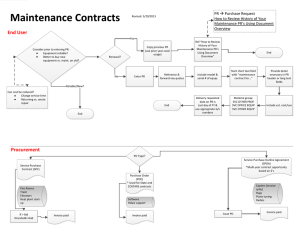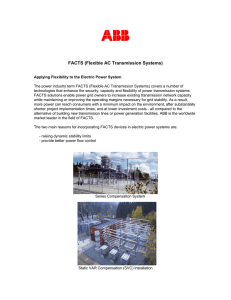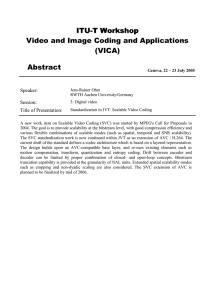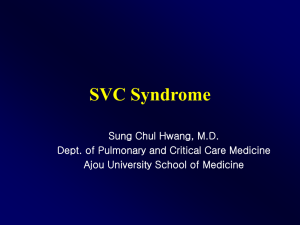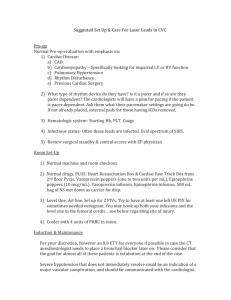adaptive control of static var compensator - Inter
advertisement
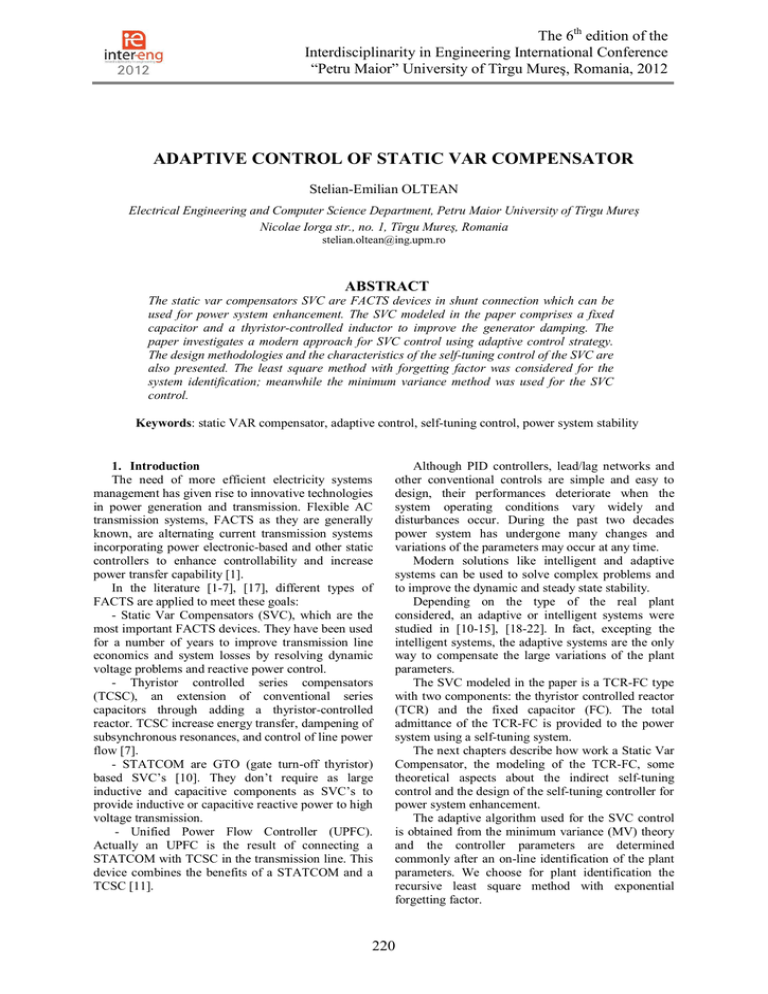
The 6th edition of the Interdisciplinarity in Engineering International Conference “Petru Maior” University of Tîrgu Mureş, Romania, 2012 ADAPTIVE CONTROL OF STATIC VAR COMPENSATOR Stelian-Emilian OLTEAN Electrical Engineering and Computer Science Department, Petru Maior University of Tîrgu Mureș Nicolae Iorga str., no. 1, Tîrgu Mureș, Romania stelian.oltean@ing.upm.ro ABSTRACT The static var compensators SVC are FACTS devices in shunt connection which can be used for power system enhancement. The SVC modeled in the paper comprises a fixed capacitor and a thyristor-controlled inductor to improve the generator damping. The paper investigates a modern approach for SVC control using adaptive control strategy. The design methodologies and the characteristics of the self-tuning control of the SVC are also presented. The least square method with forgetting factor was considered for the system identification; meanwhile the minimum variance method was used for the SVC control. Keywords: static VAR compensator, adaptive control, self-tuning control, power system stability 1. Introduction The need of more efficient electricity systems management has given rise to innovative technologies in power generation and transmission. Flexible AC transmission systems, FACTS as they are generally known, are alternating current transmission systems incorporating power electronic-based and other static controllers to enhance controllability and increase power transfer capability [1]. In the literature [1-7], [17], different types of FACTS are applied to meet these goals: - Static Var Compensators (SVC), which are the most important FACTS devices. They have been used for a number of years to improve transmission line economics and system losses by resolving dynamic voltage problems and reactive power control. - Thyristor controlled series compensators (TCSC), an extension of conventional series capacitors through adding a thyristor-controlled reactor. TCSC increase energy transfer, dampening of subsynchronous resonances, and control of line power flow [7]. - STATCOM are GTO (gate turn-off thyristor) based SVC’s [10]. They don’t require as large inductive and capacitive components as SVC’s to provide inductive or capacitive reactive power to high voltage transmission. - Unified Power Flow Controller (UPFC). Actually an UPFC is the result of connecting a STATCOM with TCSC in the transmission line. This device combines the benefits of a STATCOM and a TCSC [11]. Although PID controllers, lead/lag networks and other conventional controls are simple and easy to design, their performances deteriorate when the system operating conditions vary widely and disturbances occur. During the past two decades power system has undergone many changes and variations of the parameters may occur at any time. Modern solutions like intelligent and adaptive systems can be used to solve complex problems and to improve the dynamic and steady state stability. Depending on the type of the real plant considered, an adaptive or intelligent systems were studied in [10-15], [18-22]. In fact, excepting the intelligent systems, the adaptive systems are the only way to compensate the large variations of the plant parameters. The SVC modeled in the paper is a TCR-FC type with two components: the thyristor controlled reactor (TCR) and the fixed capacitor (FC). The total admittance of the TCR-FC is provided to the power system using a self-tuning system. The next chapters describe how work a Static Var Compensator, the modeling of the TCR-FC, some theoretical aspects about the indirect self-tuning control and the design of the self-tuning controller for power system enhancement. The adaptive algorithm used for the SVC control is obtained from the minimum variance (MV) theory and the controller parameters are determined commonly after an on-line identification of the plant parameters. We choose for plant identification the recursive least square method with exponential forgetting factor. 220 2. The SVC operation principles The particular SVC modeled in this chapter consists of a thyristor controlled reactor (TCR) stage to provide the lagging vars and a fixed capacitor FC which offer the leading vars. The lagging reactive power (inductive reactive power) and TCR current amplitude can be controlled continuously by varying the thyristor firing angle between 90 and 180. The TCR firing angle can be fully changed within one cycle of the fundamental frequency, thus providing smooth and fast control of reactive power supplied to the system [13], [17]. Fig. 2 – TSC control Applications with only TSC's are also available, providing stepwise control of capacitive reactive power, but improved performances can be obtained by using a fixed capacitor (FC) connected in parallel with thyristor controlled reactor (TCR), resulting a TCR-FC configuration like in [5], [12]. So, the TCR-FC can be seen as an adjustable reactance that can perform both inductive and capacitive compensation. The reactive power injection of a SVC connected to a busbar and the total admittance of the SVC are given by (1). QSVC BSVC V 2 (1) BSVC BC B L In (1) QSVC is the reactive power injection of the SVC (TCR-FC type), BSVC the admittance of the SVC, BC the constant admittance of the fixed capacitor and BL the variable admittance of the thyristor controlled reactor. For a TCR-FC compensator the admittance depends on firing angle α [13]. Fig. 1 – TCR control B SVC The leading vars (capacitive reactive power) are provided by a different number of capacitor bank units (only one bank is shown in the diagram) which are switched on or off in steps. The capacitor switching operation is completed within one cycle of the fundamental frequency and the TSC provides a faster and more reliable solution to capacitor switching than conventional mechanical switching devices [13]. An alternative current filter is usually used to reduce and absorb the harmonic current components generated by TCR. Thus, the leading vars are switched in steps, the lagging vars can be varied smoothly. By combining these two components, fixed capacitor and continuously controlled reactor, a smooth variation in reactive power can be achieved and the sum of the reactive power becomes linear. 1 BL XC 2 2 sin 2 B L X L (2) The inductive reactance and capacitive reactance are XL and XC. 3. Theoretical aspects on indirect self-tuning control with MV and LSM algorithms Adaptive controls are well suited for systems with unknown changes (parametrical, nonlinearities or disturbances). In these modern strategies the controller parameters can be initially tuned and online modified by the adaptation mechanism. In the literature are two major directions: model reference adaptive control and model identification adaptive 221 control (usually named self-tuning control). Both of these modern controls it can have a direct or indirect parameter modification scheme [16], [20], [22]. The adaptive system considered in the paper is the self-tuning control, which actually has a model identification indirect adaptive scheme. The block diagram is presented in figure 3 and contains four major parts: the adjustable controller, the plant, the plant identification block and the adjustable mechanism [16]. Initial value of matrix F determines influence of initial parameter estimations to the identification. Using the plant parameters obtained from the identification block the adjustment mechanism will modify the parameters of the controller. The controller designed in the next chapters is a direct digital control type with minimum variance MV algorithm. The direct digital controls DDC are designed to replace conventional controllers with numerical algorithms, which in most cases are determined by minimizing different criteria. The minimum variance MV algorithm supposes a control signal so that the variance of the error signal is minimized [16]. 2 (5) J (u (k )) M y ( k ) y pr (k ) Fig. 3 – Indirect self-tuning control The plant in our case will be the power system and SVC connected to the generator busbar. The plant parameters are identified at every discrete moment using the input and output data from the plant by the identification block. The most practical identification algorithm is the least squares method LSM or other variant of this type [16]. These kinds of methods can be used for the discrete on-line identification of processes that are described by the following transfer function: H z 1 b0 b1 z 1 ... bm z m d z 1 a1 z 1 ... bn z n 4. Self-tuning control of the SVC for power system enhancement The block diagrams from figure 4 show the power system enhancement using the self-tuning control of the SVC. We borrowed the single machine infinite bus theory consists of a synchronous generator connected via a transmission line, represented by reactance xe, to a large power system, represented by the infinite busbar. The static VAR compensator will be located at the generator busbar to provide significant damping during transient conditions [4], [7], [15]. (3) The main disadvantage of the pure recursive least square method is the absence of signal weighting. Each input and output affect result by the same weight, but actual process parameters can change in time. Thus newer inputs and outputs should affect output more than older values. This problem can be solved by exponential forgetting method. The parameters are recursively estimated using the least square method with an exponential forgetting factor with the algorithm (4). k 1 k K k 1 k 1 y k 1 T k 1 k F k k 1 K k 1 T k 1 F k k 1 1 F k 1 F k K k 1 T k 1 F k 1 where computed Fig. 4 – Indirect self-tuning control of the SVC (4) k [a1 a2 ...an b0 b1...bm ] are the process parameter estimations; T k [ yk 1... yk n uk d uk d m]T contains the output and input values; F(k) the covariance matrix updated in each step; K(k+1) the parameters identification gains, ε(k+1) the identification error, λ forgetting factor (0..1). Although the synchronous generator can be described by Park’s nonlinear relationships, at the sampling instant t=kTs the adaptive system uses a discrete second order linear model. (6) A q 1 yk B q 1 u k Where y(k) is the sampled output (generator speed deviation) at instant k, u(k) sampled input uS of the SVC, Ts sampling period, q-1 backward shift operator, k sampling instant, A and B the second order polynomials (7). 222 A q 1 1 a1q 1 a2 q 2 B (q 1 ) b0 q 1 b1q 2 (7) The discrete second order model of the power plant with SVC is transformed in a second order difference equation. y (k ) a1 y (k 1) a2 y (k 2) Figure 4 highlights in the second diagram the auxiliary adaptive control loop diagram of the SVC to improve the dynamic performance of the integrated system. The dynamic equation (11) describes the control loop of the SVC. BS (8) b0u (k 1) b1u (k 2) The LMS identification block has the goal to estimate recursively in real time the four coefficients of the relation (8) by continuously measuring the input samples u(k) and the output samples y(k). If the reference for the speed deviation is zeros the minimum variance DDC controller has the algorithm (9), which is the minimization of relation (5). u k G q 1 y k B q 1 F q 1 (9) where the G and F are the DDC-MV controller polynomials. F q 1 1 G (q 1 ) g 0 g1q 1 (10) The coefficients of the controller polynomials depend on the coefficients of the plant polynomials (g0=-a1, g1=-a2). The plant parameters are considered unknown (varies in time) and being identified by the LSM identification block, which means the controller parameters are also modified in every sampling instant by the adjustment mechanism. So, because the coefficients of the DDC controller are updated continuously using the minimum variance algorithm, the computed control signal u(k) can be considered an optimal instant value. K SVC B BS 0 K SVC Vref Vt S u S (11) TSVC TSVC TSVC In the design procedure the generator is also equipped with an automatic voltage regulator AVR for the field voltage Efd, characterized by a first order model (12), time constant TAVR and constant KAVR. E fd K AVR 1 Vref Vt E fd TAVR TAVR (12) 5. Simulations and experimental results In figure 5 is shown the SVC self-tuning control diagram for power system stability enhancement used for simulations. In the diagram the SMIB block contains the model of the generator connected through a transmission line to an infinite busbar. This block has as inputs the field voltage Efd, the mechanical torque Tm, the infinite busbar voltage Vb, where we will simulate the fault and the SVC admittance BS, modified by the SVC adaptive control loop. In the SMIB model, the generator and the static VAR compensator are connected to the same busbar, characterized by voltage Vt. The static VAR compensation is adjusted to exchange capacitive or inductive current to the system and to damp the rotor angle and speed oscillations. Fig. 5 – SVC control scheme (Matlab/Simulink) 223 The following parameters were used for the simulation (p.u.): Transmission line xe=0.2; Generator xd=2; xq=2; t’d0=5; H=3; x’d=0.3; Tm=0.5; Kd=2; AVR KAVR=100; TAVR=0.1; SVC Bsmin=-0.3; Bsmax=0.3; Bs0=0.1; usmin=-0.2; usmax=0.2; Ksvc=50; Tsvc=0.1; First case that we have studied was the behavior of the power system after a 0.5 second fault (3-phase short-circuit) near the infinite busbar without the auxiliary signal provided by the adaptive loop. The figure 6 shows the evolutions of the rotor angle and the speed deviation after the fault. The SVC conventional loop tries to damp the oscillation of the signals, but the performances are not so good, because the settling time is about 25 seconds. Fig. 7 – Rotor angle, speed and total admittance Fig. 6 – Rotor angle and speed In the second case in the simulations we considered the same fault (0.5 second 3 phase shortcircuit), but with the auxiliary adaptive loop for the SVC control. Figure 7 shows the rotor angle, speed and the total admittance in presence of the auxiliary signal provided by the self-tuning controller. The self-tuning controller has an important role in damping the oscillation caused by the temporary fault. So, the SVC control loop including the selftuning controller damps the oscillation in a more efficient way and the settling time is reduced to 10 seconds. 6. Conclusions The paper presents the adaptive control of a static var compensator for power system enhancement. The single machine infinite busbar SMIB theory and model were used for power system configuration and the simulations and experimental results were obtained using Matlab-Simulink software. A type of SVC was investigated in this paper to improve transmission line economics and system losses by resolving dynamic voltage problems and reactive power control. The TCR-FC (thyristor controlled reactor TCR and fixed capacitor FC) was located on the generator busbar and the behavior of the power system was studied after the 3 phase shortcircuit that occurs near the infinite busbar. This type of SVC can be seen as an adjustable reactance that can perform both inductive and capacitive compensation to improve the quality of the power system. To provide significant damping during transient conditions on power system the SVC control diagram uses a conventional SVC loop and an auxiliary signal 224 computed by the self-tuning controller. The plant parameters were identified at every discrete moment using the input and output data from the plant by the identification block using the least squares method with an exponential forgetting factor. Using the plant parameters obtained from the identification block the adjustment mechanism modified continuously the parameters of the minimum variance based controller. The main goal of introducing the auxiliary loop was to damp the oscillations of the rotor angle after the fault. Comparative results made after the simulations with the adaptive controller auxiliary loop emphasized a shorter settling time and a better damping of the power system oscillations. [10] [11] [12] [13] References [1] Mithulananthan, N., Cañizares,C.A., Reeve, J. and Rogers, G.J. (2003), Comparison of PSSS, SVC and STATCOM Controllers for Damping Power System Oscillations, IEEE Transactions on Power Systems, vol. 18, no. 2, pp. 786-792. [2] Farsangi, M.M., Song, Y.H. and Lee, K.Y. (2004), Choice of FACTS device control inputs for damping interarea oscillations, IEEE Trans. on Power Systems, vol. 19, no. 2, pp. 11351143. [3] Zellagui, M., Chaghi, A. (2012), Effects of shunt FACTS devices on MHO distance protection setting in 400 kV transmission line, Electrical and Electronic Engineering, vol. 3 (2), pp. 164-169. [4] Hingorani, N. G. and Gyugyi, L., (2000), Understanding FACTS: Concepts and technology of flexible AC transmission systems, IEEE Press. [5] Kodsi, S., Cañizares, C.A. and Kazerani, M. (2006), Reactive current control through SVC for load power factor correction, Electric Power Systems Research, vol. 76, pp. 701-708. [6] Zou, Z., Jiang, Q. J., Cao, Y. J. and Wang, H. F. (2005), Normal form analysis of interactions among multiple SVC controllers in power systems,” Proceedings of IEEE Generation, Transmission and Distribution, vol. 152, pp. 469-474. [7] Panda, S. and Padhy, N.P. (2007), Matlab/Simulink based model of single machine infinite bus with TCSC for stability studies and tuning employing GA, International Journal of Electrical and Electronics Engineering, vol. 1 (5), pp. 314-323. [8] Li, L. F., Liu, K. P. and Ma, L. (2005), Intelligent control strategy of SVC, IEEE/PES Transmission and Distribution Conference & Exhibition. [9] Banga, A. and Kaushik, S.S., (2011), Modeling and simulation of SVC controller for enhancement of power system stability, [14] [15] [16] [17] [18] [19] [20] [21] [22] 225 International Journal of Advances in Engineering & Technology, vol. 3, pp. 79-84. Zolghadri, M.R. (2006), Power System Transient Stability Improvement Using Fuzzy Controlled STATCOM, IEEE Proc. Power System Technology, pp. 1-6. Dash, P. K., Morris, S. and Mishra, S. (2004), Design of a nonlinear variable-gain fuzzy controller for FACTS devices, IEEE Trans. on Control Systems Tech., vol. 12, pp. 428-438. Mishra, Y., Mishra, S. and Dong, Z.Y. (2008), Rough Fuzzy Control of SVC for Power System Stability Enhancement, Journal of Electrical Engineering & Technology, vol. 3, no. 3, pp. 337-345. Karpagam, N., and Devaraj, D. (2009), Fuzzy logic control of static VAR compensator for power system damping, International Journal of Electrical and Electronics Eng., pp. 3–10. Miranda, V. (2007), An improved fuzzy inference system for voltage/VAR control, IEEE Transaction on Power Systems, vol. 22, issue 4, pp. 2013-2020. Dash, P. K., Mishra, S. and Liew, A. C. (1995), Fuzzy logic based VAR stabilizer for power system control, IEEE Proc. Generation, Transmission and Distribution, vol. 142, pp. 618-624. Tao, G., (2003), Adaptive control design and analysis, John Wiley and Sons, New York. Oltean, S.E. (2012), Modern control of static var compensator for power system stability enhancement, Scientific Bulletin of the „Petru Maior” University of Tîrgu Mureş, vol. 9 (XXVI), no. 1, pp. 33-37. Hsu, Y.Y. and Cheng C.H., (1987), Design of a static VAR compensator using model reference adaptive control, Electric Power Systems Research, vol. 13, pp. 129 – 138. Dash, P.K., Sharaf, A.M. and Hill E.F., An adaptive stabilizer for thyristor controlled static var compensators for power systems, IEEE Transactions on Power Systems, vol. 4, no. 2, pp. 403-410. Fusco G. and Russo M., (2004), Performance comparison between self-tuning and model reference based adaptive schemes for nodal voltage regulation in power systems, Proceedings on Control 2004, UK, ID 108. Djagarov, N.F., Grozdev, Z.G., Bonev, M.B. and Georgiev, G.D., (2006), An adaptive control of static var compensator on power systems, International Conference on Energy & Environmental Systems, pp. 151-157. Rahima, A.H.M.A., Nowicki, E.P. and Malik, O.P., (2006), Enhancement of power system dynamic performance through an on-line selftuning adaptive SVC controller, Electric Power Systems Research, vol. 76, pp. 801–807.
